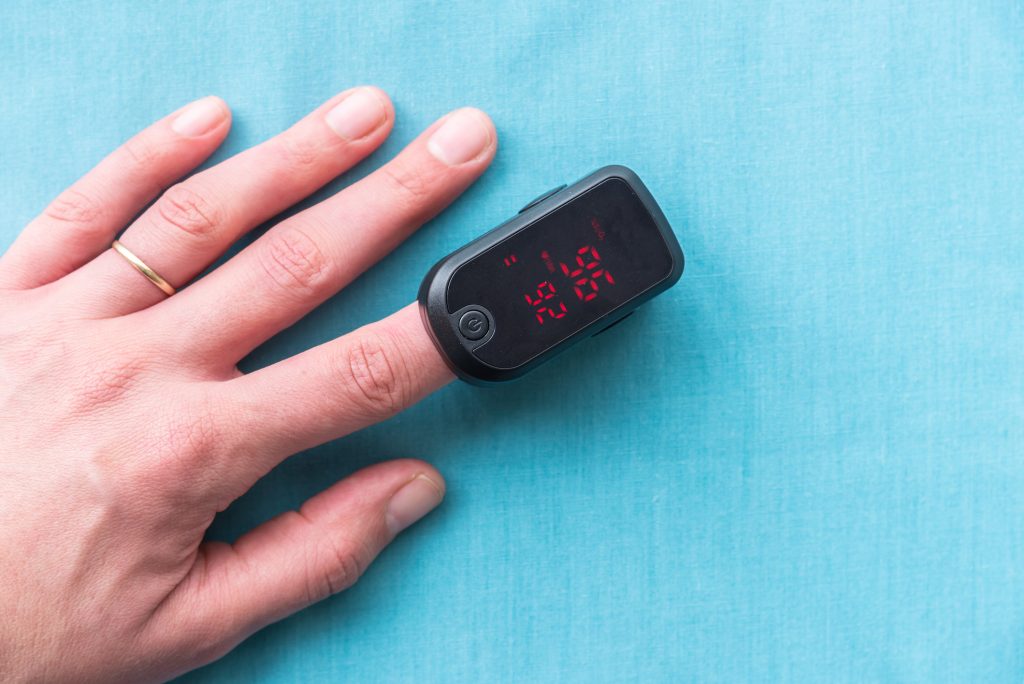Over the long term, low blood-oxygen levels (hypoxemia) can lower your quality of life severely — and lead to death. Diagnosing hypoxemia, assessing oxygen needs, and starting oxygen therapy is key to living a better life with Alpha-1 lung disease.
Download Assessing Oxygen Needs – Now and in the Future as a PDF.
Do you have hypoxemia?
The most accurate way to determine the presence of hypoxemia is to test your “arterial blood gases,” also called ABGs. This test also gives levels for oxygen, carbon dioxide, and other elements, such as blood pH and bicarbonate. Your healthcare practitioner can use an ABG test to establish your “baseline” condition. Declining oxygen levels may lead them to recommend oxygen therapy.
Your healthcare practitioner may also use pulse oximetry to test your blood oxygen levels. A pulse oximeter is a small device that clips onto your finger or ear lobe. It “reads” your oxygen level through your skin. Since the device is easy to use, you can test your own blood oxygen levels. This is helpful for ongoing testing once you have your baseline. However, pulse oximetry doesn’t provide levels for carbon dioxide or other blood gases.
Assessing oxygen needs under different conditions
Pulse oximetry is easy to perform and provides instant results. It doesn’t require lab analysis, and it can be done in a range of settings. For example, if you have symptoms of hypoxemia while you’re exercising, you can test your oxygen level while you’re on a treadmill or stationary bike. You can even test blood oxygen while you’re sleeping!
Assessing oxygen needs over time
If you have an acute infection or your symptoms get worse suddenly, your healthcare practitioner may order oxygen therapy. In these instances, it’s good to reassess your need after 1-3 months. You may no longer need oxygen therapy.
Once you start regular, long-term oxygen therapy, you can use pulse oximetry to reassess your oxygen needs if your health changes.
Official criteria for supplemental oxygen therapy
Medicare and other third-party payers use specific blood test criteria to decide when oxygen therapy should be prescribed. They also have criteria for deciding how much they’ll reimburse for the cost.
Medical experts set these criteria, which state the blood oxygen levels that call for the use of supplemental oxygen.
These guidelines describe three specific conditions that call for the use of oxygen therapy. This information may be helpful when you’re looking at your test results:
- PaO2 is less than or equal to 55 mmHg or hemoglobin oxygen saturation (SaO2) is less than or equal to 88% when breathing room air while at rest.
- PaO2 of 56-59 mmHg or if SaO2 is equal to or less than 89% when associated with specific clinical situations (such as cor pulmonale, congestive heart failure, or polycythemia with a hematocrit of greater than 56 percent).
- Some individuals do not qualify for oxygen therapy while at rest but may require supplemental oxygen while walking, exercising, or sleeping. (Note: Some payers may ask for proof that oxygen therapy helps with hypoxemia.)
Learn more about what your test results mean.
Understand your oxygen prescription
The oxygen prescription your healthcare practitioner writes tells you how much oxygen to use at rest, and during exercise or sleep. This prescription may include different flow rates for each of these activities.
Your prescription should list:
- a disease diagnosis, like Alpha-1 COPD
- type of oxygen system
- flow rate expressed in liters per minute
- duration (number of hours per day)
For more in-depth information on this topic, please visit the Big Fat Reference Guide (BFRG). If you are enrolled in AlphaNet’s Subscriber Portal, you can access the BFRG here.
Download Assessing Oxygen Needs – Now and in the Future as a PDF.

